You’ve been working hard to make THAT QUILT. You know what I mean- the quilt that you can’t wait to show off to anyone that will look at it. What’s the best way to get lots of interested eyes on your quilt? Entering a quilt show!
The tips are coming up, but first let’s talk about the kind of show this post focuses on.
The Shows
For the purposes of this post I am focusing on juried quilt shows that are typically found at the Regional/National/International level. A few popular juried shows in the US include:
- American Quilter’s Society (AQS): several shows in different locations throughout the year including a Spring show in Paducah, Kentucky
- The Great Wisconsin Quilt Show: Held each September as a PBS fundraiser
- International Quilt Festival: Best known for their Fall show in Houston, Texas
- Mancuso: several shows in different locations throughout the year
- QuiltCon: An annual show held by the Modern Quilt Guild which is a non-profit organization
- Road to California: hosts a show in January each year
There are tons of other shows both small and major around the world. County and State Fairs are a great place to start if you would like to start entering on a local level, and they don’t typically have juries, so everything entered gets displayed!
If you are a quilter who is creating your own designs, you may also want to check out entries for art exhibits, particularly those featuring textiles. These are often pretty competitive, but quilts can really have a chance to stand out when they are in this type of show.
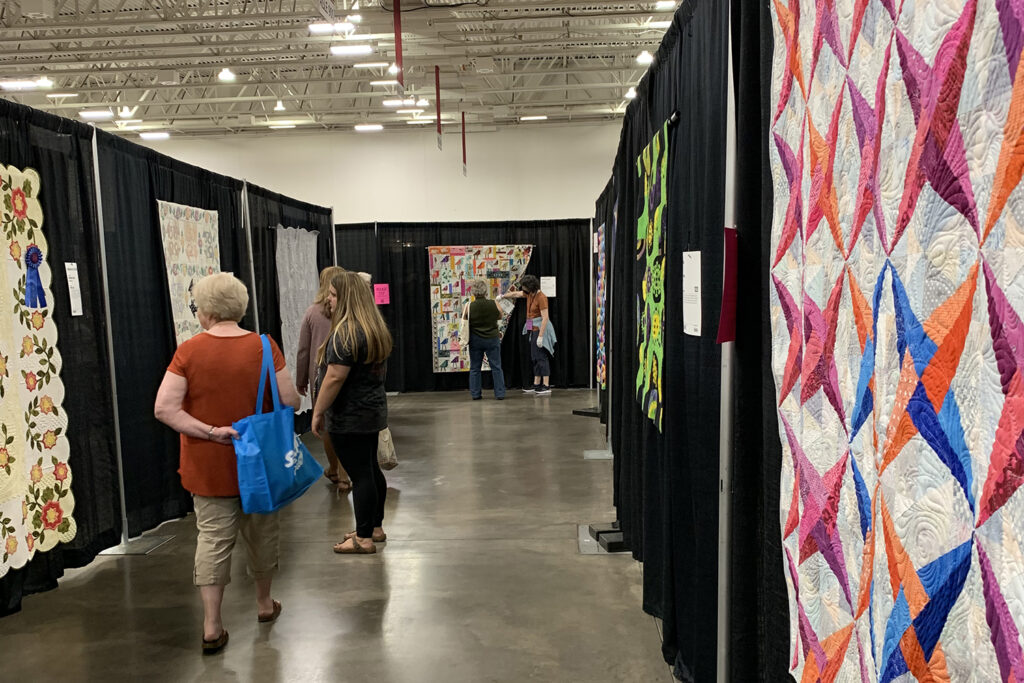
What is a a Juried Show?
A juried show requires the entrant to submit photographs and information about their quilt to the show well in advance. A group of people the show has selected as their jury then reviews each entry and determines if it is the right fit to be displayed in that show for that particular year. Most quilt shows keep the jury anonymous.
How is Jurying different than Judging?
The jury determines which quilts are displayed at a particular show. Judging occurs once the quilts are at the show. The judges names are generally listed with show information during the show, and sometimes they are announced beforehand. The judges determine which quilts receive awards and often (but not always) provide written feedback on each quilt.
Now that we’re on the same page about what exactly a juried show is, let’s get to those tips!
1. Know the Rules
Read the entire set of rules for each quilt show every year. The first time you enter a show, you probably make sure to read the rules, but after a few years, it’s easy to think you know what’s up. However, many shows have annual updates to the rules that can be easy to miss, so the entry guidelines are worth an annual read.
Things to watch for:
- Categories: These frequently change between shows
- Acceptable Quilt Sizes: This one can catch a lot of people. In 2020 I had a quilt accepted into several AQS shows that were later canceled. When shows returned in 2022, the acceptable sizes for many categories had changed, and the quilt that had been accepted in 2020 couldn’t even be entered in 2022.
- Photograph size requirements: These vary from show to show, and sometimes don’t always make sense (you want how many pixels to fit in that size file?!!) I have found the most important criteria is the overall MB size of each photo.
- Labeling: WooHoo! Your quilt has been accepted. Make sure you check the rules for labeling information, and how the show wants the label covered for judging. Some shows want just the quilt title visible, others want the quilt title, others just want it covered, or don’t care. Most shows will remind you of what they prefer in the acceptance information, but some leave this part out.
2. Dates are Critical
Timing is everything! Once you enter one show, there is a good chance you will want to enter more. Quilters spend years figuring out how to enter the most shows with a single quilt. Each quilter’s show priorities are different, but here are some questions to ask yourself as you get started:
When did you make the quilt?
Quilt shows tend to want quilts that are relatively new. This usually means that you will need to enter quilts that were completed in the last 1-5 years depending on the show rules.
What is the entry deadline?
Entries are due really early. Expect to enter contest quilts 3-6 months prior to national/international shows. Some regional contests have deadlines much closer to the show itself.
How long will your quilt be at the show?
The process for unpacking, organizing, judging, and hanging quilts for display is very involved. Some shows will require your quilt to be sent to them several weeks before the doors open to the public. Occasionally shows will have a very small window available for entries to arrive, so watch these dates carefully. Quilts are generally returned to you the week following the show, but there are occasionally exceptions to this if your quilt is held for another show with the same company (AQS offers this service for their shows), your quilt is needed for additional photography, or the quilt is included in a traveling exhibit.
Will these dates work with other shows?
A quilt can be with a single show for well over a month, so determining which shows a single quilt can be exhibited in can be challenging. I recommend adding all of the dates for shows you are interested in to a calendar and checking for overlap. As a quilter who tends to enter both QuiltCon and all of the AQS shows, I know that a single quilt can make it to both QuiltCon in February and the April AQS show in Paducah, but that same quilt cannot make it to the March AQS show.
3. Budget Your Entries
Costs have gone up on a lot of things in the past few years, and entering quilt shows is no exception.
Entry Fees
Entry Fees vary widely between shows. In the past year I have entered shows with fees of $10-$60 and everything in between. The lowest cost shows tend to be regional. The shows with the highest entry fees frequently allow for 2-3 entries for the flat fee. This is a decent deal if you have a few pieces to enter, but not great if you only have one entry. The majority of national/international shows are in the $20-$30 per entry range right now.
Shipping
Shipping costs tend to vary widely depending on the service you use. I do next to no international shipping, so I can only speak to my experience with domestic US shipping. I don’t use the post office to ship show quilts. While the chance of something being lost is small, I like to have lots of tracking information. If you add insurance to your packages, USPS often ends up costing way more than FedEx or UPS. I typically spend $20-$30 at FedEx to ship one or two quilts to a show in a single box. UPS is generally less expensive, but I have had packages lost with them (thankfully not quilts- knock on wood!), so I am hesitant to send irreplaceable items with them. Regardless of which service you use, setting up an account will save you money. I have an account directly with FedEx and I use Pirate Ship for UPS and USPS.
Return shipping can be even more pricey. I was recently charged $40 per quilt to have my quilts returned. If you are at the show, consider planning to pick your quilt up at the end to save a bunch. When my Mom and I were both entering shows, we quickly realized that we could pay for an extra night in a hotel for what return shipping was going to cost for all of our quilts. If a show allows you to send your own pre-paid shipping label, that is usually the most cost effective option if you can’t do in person pick up.
Extras
Appraisals are offered at most shows and generally cost between $60-$75 per quilt. I have had a few quilts appraised at shows, and have had a mix of quality. While always done by certified appraisers, you may not know who will be doing the appraisal and what quality you can expect. If it is an option, I tend to prefer working with an appraiser you can go to consistently.
Books and/or photographs are sometimes offered to participants. I have never purchased the photographs (this is a somewhat rare offering at this point in time), but I do tend to purchase the books with my quilts in them. AQS does a book of show quilts for their Paducah shows, and QuiltCon has recently started putting out lovely hard cover books of their annual show.
4. Photographs Matter
Photography could be a full post on its own, but let’s hit on a few basics.
Camera
If you have a phone that has been made in the last several years that is all you need to enter a quilt. You don’t need to purchase a fancy camera or have professional photos taken of your quilt (unless you want to!) The goal is to get a good photo that accurately represents the quilt. The jury needs photographs that allow them to see the quilt, but they are not judging the photograph itself.
Taking photos
Outdoor lighting is your friend. Overcast days are best, but a shady side of your house works too. Avoid full sun or dappled sunlight through foliage. I have a wire on the end of the house that I hand quilts on for photography, but I know several people who roll pieces of tape on the back of their quilts and stick it to a fence or garage door.
Once the quilt is up, try to keep the edges of the quilt aligned to the edges of the photo, so the quilt will appear as square in the photograph as it is in real life!
Editing photos
Try to keep photo editing to a minimum. You can (and probably should) crop out as much of the background from the photo as you can. Beyond that, make sure that any editing is to make the photograph look more like the quilt itself. Be careful to not overdo color alterations, but slight alterations to square up the quilt may be a good idea.
The most important edit is to adjust the photograph size to the largest size that can be uploaded into the entry form. Also make sure you save as a jpg or other file format accepted by the show.
5. Streamline Your Entry Process
Once you go through all of the work involved in preparing a quilt to enter in a show, you will probably want to enter it in more than one! Keeping a word processing document with all of your quilt’s vital information makes subsequent entries super easy. In this document include:
- Quilt Title
- Width and Height measurements
- Perimeter measurements
- Quilting Techniques Including if the quilting was done on a domestic/sit down machine or on a longarm with a frame, if stitch regulation was used, free motion, ruler work, walking foot, computerized designs, etc.
- Techniques you used to create the quilt top including specific types of piecing/applique/embroidery/etc.
- The types of fabric, batting, and thread used in the quilt.
- Date of completion
- Descriptions/Artist Statements: Each show has its own requirements for a description, so you may have several for each quilt. Most shows allow for 25-150 words, but some have different requirements. Many shows will include this statement with the quilt, but others will only use it internally. I suggest writing everything you want about the quilt then copying and pasting it a second time in the document to edit to an appropriate length. I never delete my longer statements because there may come a show where the extra information will be helpful
Are you ready to enter? There are lots of shows accepting entries right now, and I hope to see your quilts at some upcoming shows!

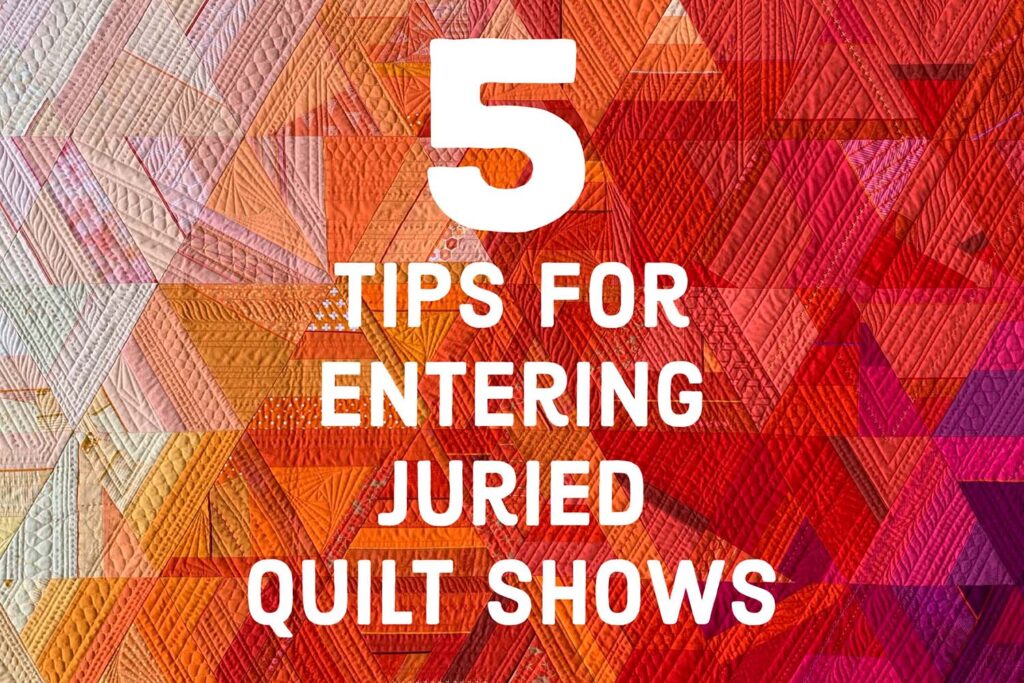






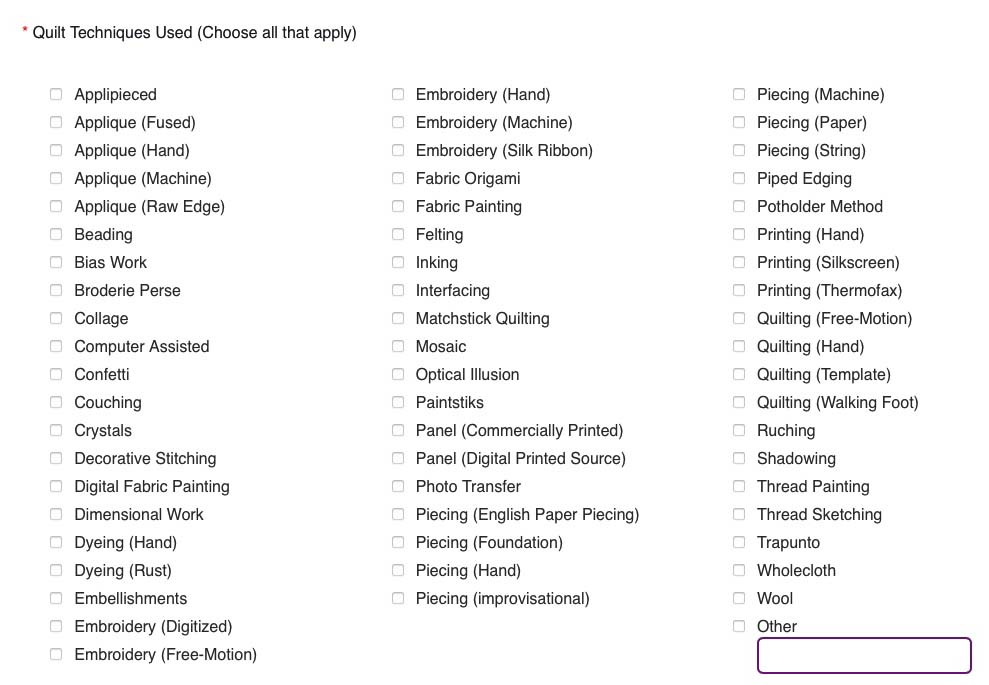
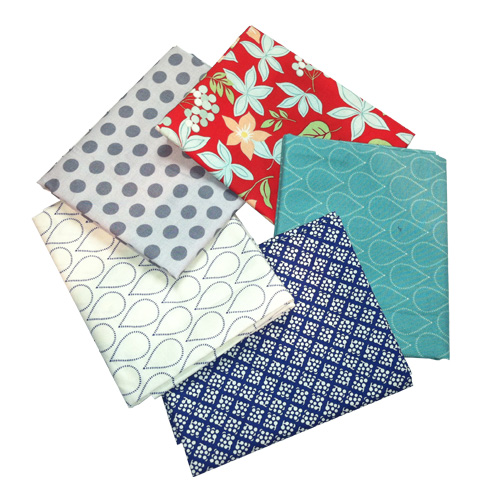



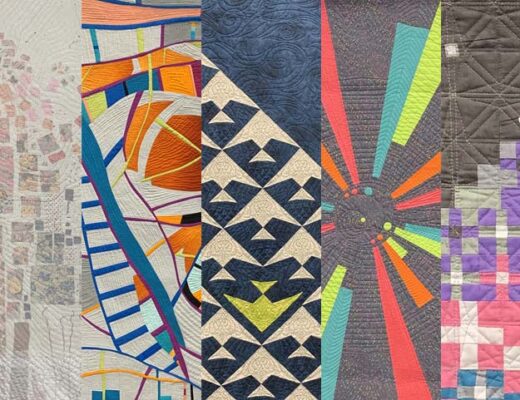
4 Comments
Linda Selby
October 7, 2022 at 9:11 amThanks Cassandra!! This is great information!
Mrs. Plum
October 7, 2022 at 11:58 amThank you for this valuable information. I have entered some juried shows, and find the process somewhat nerve-wracking. It IS exciting, though, to see one’s quilt hanging in a juried show.
Karen Bolan
October 10, 2022 at 11:02 amI’m curious if you’ve ever gotten judges comments about the sleeve. Sleeves are often done at the last minute here and my handwork isn’t always good. Nice overview!
thenotsodramaticlifeadmin
December 12, 2022 at 11:57 pmI have never heard about anyone receiving sleeve-related comments, but that doesn’t mean it hasn’t happened. From my point of view, the most important parts of a sleeve are 1) the sleeve is secure, 2) it doesn’t have stitches coming through to the front of the quilt, and 3) it is level enough that the quilt doesn’t distort when the quilt is hanging for display.